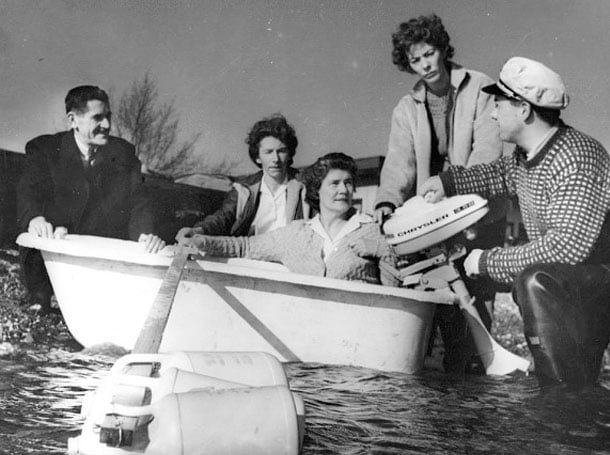Canada Day is nearly upon us: a time to gather around the barbeque, a time to reminisce about the country's history, and a time (apparently) to sport our nation's flag as a cape.
There are certainly plenty of high-stakes moments to discuss: the Last Spike, Wolfe and Montcalm at the Plains of Abraham, the Klondike Gold Rush. But for every moment that's officially Part of Our Heritage, there are those that have been lost to the mists of history. In other words, for every John A. MacDonald, there's an Amor DeCosmos.
Which is why we at The Tyee have banded together to do our patriotic duty and collect some less-well-known, made-in-British Columbia moments to share with your fellow Canadians this July 1 -- a handful of happenings that made the rest of the nation take notice, for good or ill. Share your own stories around the virtual campfire that is the comment thread below.
1. The time an American fighter jet crashed into Grouse Mountain
On the afternoon of Feb. 13, 1954, Grouse Mountain skier Ray Nunn was greeted with an unusual sight. Having arrived at his cabin for the weekend, he noticed that his front yard was littered with what appeared to be airplane fuselage. In fact, the wreckage was that of a heavily-armed USAF F-86 fighter jet which, through some bizarre combination of instrument failure, radar malfunction, and heavy fog had crashed into the side of the mountain, 200 feet from the chairlift and less than 15 feet from Nunn's front door.
"It was awful low when it came out of the clouds, and it was going very fast," six-year-old Robin McPherson -- the only eyewitness to the crash -- explained to the Province newspaper. "Then it sort of zoomed up and went in the trees on the side of the mountain. I didn't hear any noise like a bang."
Within hours the area was swarming with reporters and investigators, all trying desperately to determine how the aircraft, which had taken off from Tacoma that morning loaded with classified weaponry and an arsenal of 24 rockets, had made its way so far north. The pilot, Second Lieutenant Lamar Barlow, was the only casualty in the crash, having been unable or unwilling to parachute to safety (his body was found in the wreckage, still strapped in his flight harness).
"All our boys are instructed to jump by parachute if they get into a tight spot," Major C.D. Sawtelle would later tell the Province. "However, if he knew he might kill many other people if he left his plane, he would decide to stick with it."
It would later be determined that Barlow's instruments had failed somewhere near Blaine and that a radar "echo" had led operators on the ground to give Barlow incorrect directions, leading him to accidentally slam directly into the mountainside. Mercifully, none of the 24 rockets on board had detonated; each had the explosive power of a 250-pound bomb.
The engine remains on Grouse Mountain today, now a memorial for Barlow.
2. The time we invented bathtub racing
Frank Ney was a man with a dream. He wanted to put his town, Nanaimo, on the map, and in the summer of 1967 the city's Centennial Committee had figured out just how to do it. Glen Galloway, a salesman at Ney's firm, Nanaimo Realty, had suggested an event to coincide with both the country's upcoming centennial and Vancouver's annual Sea Festival. And thus, with the committee's approval and Ney's blessing, the first annual Great Bathtub Race was born, taking 200 hardy participants on a 58-kilometre course from Nanaimo to Vancouver in homemade bathtub boats.
The race appealed to Ney's peculiar sensibility. A former hockey player, RCAF pilot, developer, and Nanaimo's mayor (on and off) for more than two decades, he'd become known for his eccentricities, which included attending civic events dressed as a pirate. He was also a tireless proponent of Nanaimo itself and responsible for many of the city's more unusual street names, including Twiggly Wiggly Road, Jingle Pot Road, and Buttertubs Drive. Under Ney's guidance the Bathtub Race became an annual tradition, garnering media attention from all over the world. In the early years, amateurs mostly made the tubs, and very few racers (47 of the initial 200 in 1967) made it to the finish line. Today, the race celebrates its 50th anniversary, having outlived Ney himself and grown into a three-day festival that features beer gardens, fireworks and parades.
Ney's pride in the event was evident in the speech he gave to racers who crossed the finish line at the 1969 race, where he praised their "raw courage, and true bathtub seamanship" and declared proudly to the crowd of 5,000 that "we have again proven conclusively and incontrovertibly that B.C. leads the world in bathtub technology."
Today, a bronze statue of Ney stands in downtown Nanaimo. He is portrayed in full pirate attire.
3. The time we accidentally did the first orca capture in history -- and then accidentally killed it
Before the mid-1960s, virtually nothing was known about the creatures then known as "killer whales." They were believed to be ferocious predators and a danger to boats, humans and marine life. All of that changed in the summer of 1964, after a chance encounter off the coast of Saturna Island resulted in the accidental capture of a live orca.
The initial plan, one common amongst the aquariums of the 1960s, was to kill one of the animals and prepare a life-sized replica for display in the Vancouver Aquarium's brand-new BC Hall. In spring 1964, a harpoon gun was mounted on a Saturna Island cliffside, manned by commercial fisherman Josef Bauer and Yugoslavian sculptor Sam Burich. However, things didn't quite go according to plan. After 57 days of waiting, then-director Murray Newman received a frantic phone call; Burich and Bauer had indeed harpooned an orca, but the shot hadn't been fatal. Instead, the harpoon had become lodged in the fatty tissue near the whale's neck, and after listening to its anguished cries, the pair had lost their nerve.
After much debate, the crew (along with Newman and UBC neuroscientist Pat McGeer) towed the whale back to Vancouver and placed it in a pen at Burrard Drydock for observation. During the two months it remained in captivity (first at Burrard, then later near the Jericho Army Base), the whale became a major sensation. Recordings of its vocalizations were played on CBC stations across the country. A one-day open house drew more than 20,000 attendees. The orca was given several nicknames -- first "Hound Dog" and later "Moby Doll." At the same time, researchers made the first detailed observations of orca behaviour ever taken. Sam Burich in particular developed a deeper relationship with Moby Doll, spending countless hours trying to figure out the whale's diet and learning to communicate with him through a series of whistles (Moby Doll would often whistle in response).
However, despite the scientific benefits and the public's adoration, things were not going well. While the researchers had been successful at removing the harpoon and treating the wound with penicillin, their knowledge of orcas was limited and they didn't know what to feed it. And starting in early August, lesions began to appear on Moby Doll's body, a fungal infection contracted from the polluted water and confines of the Jericho enclosure. Staff attempted to combat the infection's spread through the use of copper sulfate, while Newman frantically searched for a new home for the whale. But it was too late. Moby Doll died on Oct. 9 after the fungal infection spread to his lungs. He ate one last meal, slowly circled the pool, and then submerged.
"When it was clear she [sic] wasn't coming back up, everyone at the dock was devastated," Newman later wrote in his autobiography. "At first I even kept the press at bay, refusing to let photographers into the dock area. After a few hours, I came to my senses, but it still felt like inviting a pack of strangers into the front parlour after a death in the family. 'What were we going to do now?' The reporters asked. With as much control as I had left, I replied that we intended to learn as much from her death as we had learned during the time she had been alive. Then I went home."
4. The time we captured an international train robber -- and then lost him
By spring 1906, Bill Miner had made quite a name for himself as a bandit and highwayman. The 65-year-old Miner, known variously as The Grey Fox and The Gentleman Bandit (owing to his exceptional politeness while robbing people), had already enjoyed a lengthy career holding up trains and stagecoaches throughout the United States. He also had a remarkable knack for getting caught, having previously served prison terms in Placer County, Calaveras County, and San Quentin. In 1903, Miner wandered north, and in summer 1904 was credited with committing B.C.'s first train robbery, a daring heist outside of Mission that netted him $4,000 in gold dust, $50,000 in U.S. bonds, and more than $250,000 in Australian Securities.
Remarkably, the gang never went near the passenger car (unfortunate, perhaps, considering it housed millionaire W.H. Malkin), and even left the engineer's wallet and watch untouched. Though several arrests were made Miner was never found, having escaped to the interior where he lived under the alias George Edwards, evading local law enforcement and even the Pinkertons for close to two years.
By contrast, Miner's second B.C. robbery was a disaster. In all, the gang netted a measly $15.50 and some decongestant pills. Worse, the incident led to their capture, after the Northwest Mounted Police managed to track them to the woods near Douglas Lake.
"The camp was quietly surrounded, and we commenced to close in on them," North West Mounted Police Constable William Fernie explained in an interview with the Province. "A fusillade of shots from the brush showed that they had spotted us and intended to put up a fight. This intention was altered after some score of shots had been exchanged and one of the men, supposed to be the leader, had gone down with a bullet in his thigh."
Miner, alongside accomplices William Colquhoun and "Shorty" Dun (then thought to be the leader), was taken into custody, and upon his identification was sentenced to life imprisonment in the New Westminster Penitentiary. By now, the outlaw's reputation had spread so widely, the train carrying him to the prison was met by throngs of supporters. Miner wasted no time settling into prison life and had soon gained some measure of appreciation from his captors for his exceptionally good behaviour. But it was all a sham: on August 8, 1907, less than a year after his capture, Miner escaped from prison along with three accomplices.
"They excavated a hole under the wall near the brick smokestack," the Province recounted breathlessly in its August 9 edition, "and escaped into another field of the prison grounds. Although this yard is surrounded by high fencing, the fugitives managed to scale this by means of a ladder, and got clear away into the surrounding brush."
Despite a massive manhunt, bloodhounds, extensive media coverage, and the reassurance of one Deputy Warden Bourke, Miner was never recaptured in Canada. He made his way south of the border and quickly resumed his criminal ways, robbing trains and escaping from prison several more times until he died of natural causes in 1913. ![]()

















Tyee Commenting Guidelines
Comments that violate guidelines risk being deleted, and violations may result in a temporary or permanent user ban. Maintain the spirit of good conversation to stay in the discussion.
*Please note The Tyee is not a forum for spreading misinformation about COVID-19, denying its existence or minimizing its risk to public health.
Do:
Do not: